Abstract
A collection of 169 strains, including 91 obtained from cases of gastroenteritis and 41 from localized tissue infections and infections of the eye and ear, was submitted to an extensive nutritional, physiological, and morphological characterization. The nutritional and physiological data obtained from these strains, as well as data for strains of other species of the genus Beneckea, were submitted to a numerical analysis which grouped the strains into clusters on the basis of phenotypic similarity. Strains from cases of gastroenteritis formed a group of three clusters which linked at a similarity value of 68%. These three clusters could not, however, be separated from each other by universally positive or negative traits, and on the basis of their overall phenotypic similarity were assigned to a single species, B. parahaemolytica. The majority of the strains from human, nonenteric sources segregated into two distinct clusters, one designated B. alginolytica and the other unassigned with respect to species (group C-2). B. parahaemolytica, B. alginolytica, and group C-2 could be readily distinguished from one another as well as from the remaining species of the genus Beneckea by multiple, unrelated, phenotypic traits. Activities of selected enzymes of glucose and gluconate catabolism in cell-free extracts of B. parahaemolytica, B. alginolytica, and group C-2 suggested that these organisms utilized glucose primarily via the Embden-Meyerhof pathway and gluconate primarily via the Entner-Doudoroff pathway. Similar results were observed in the other members of the genus Beneckea.
Full text
PDF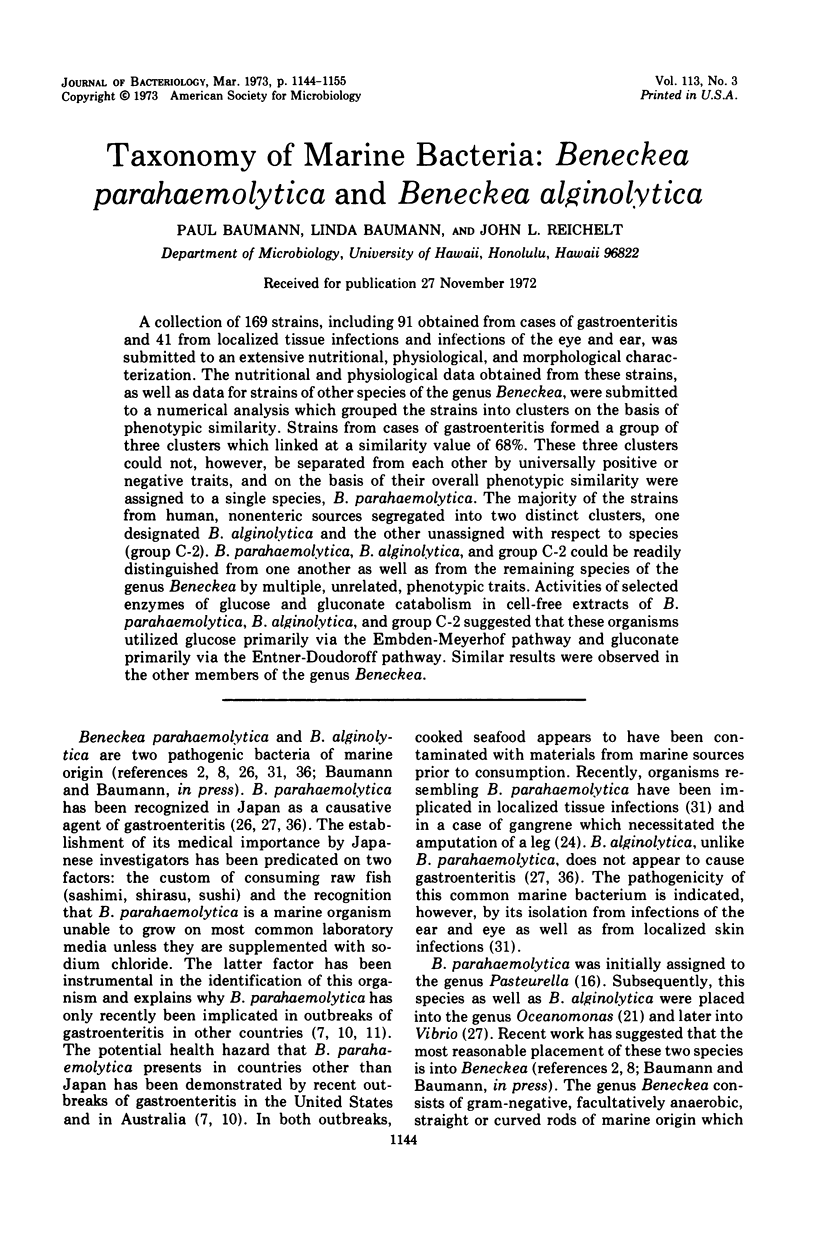
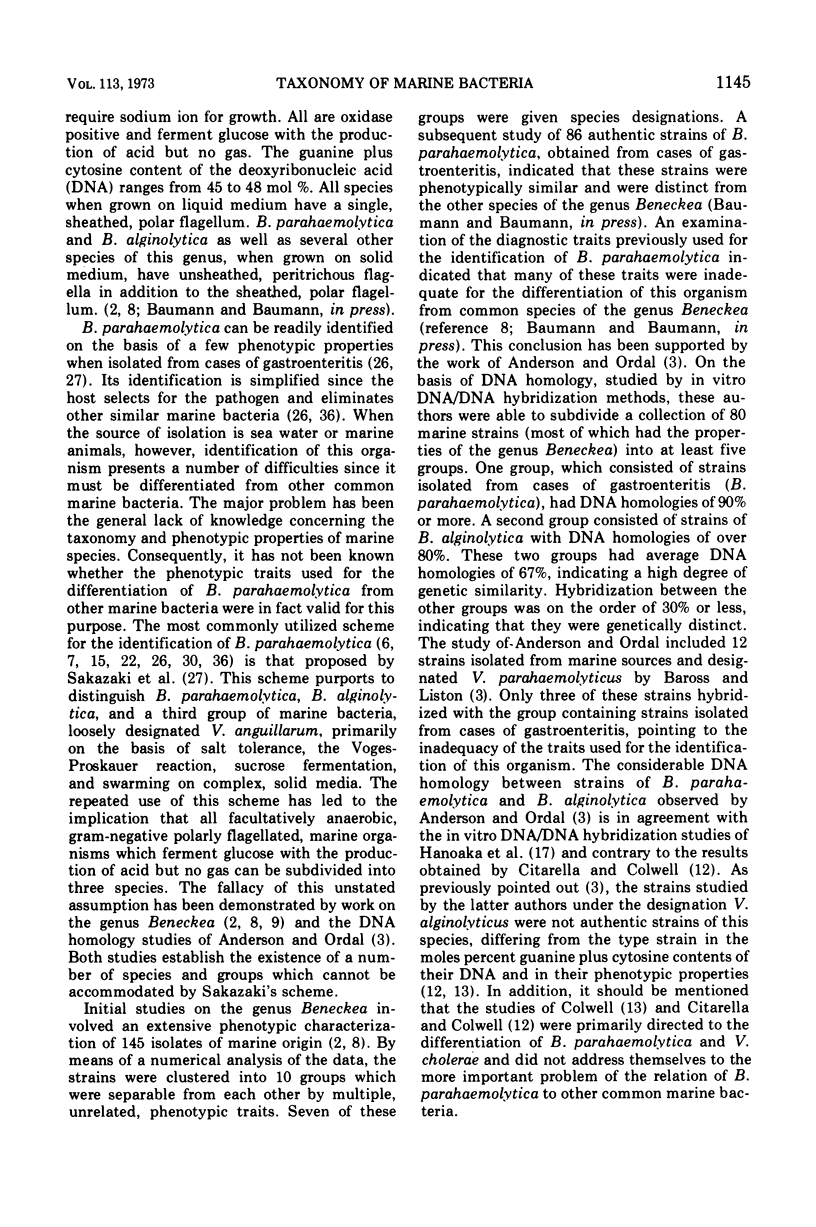
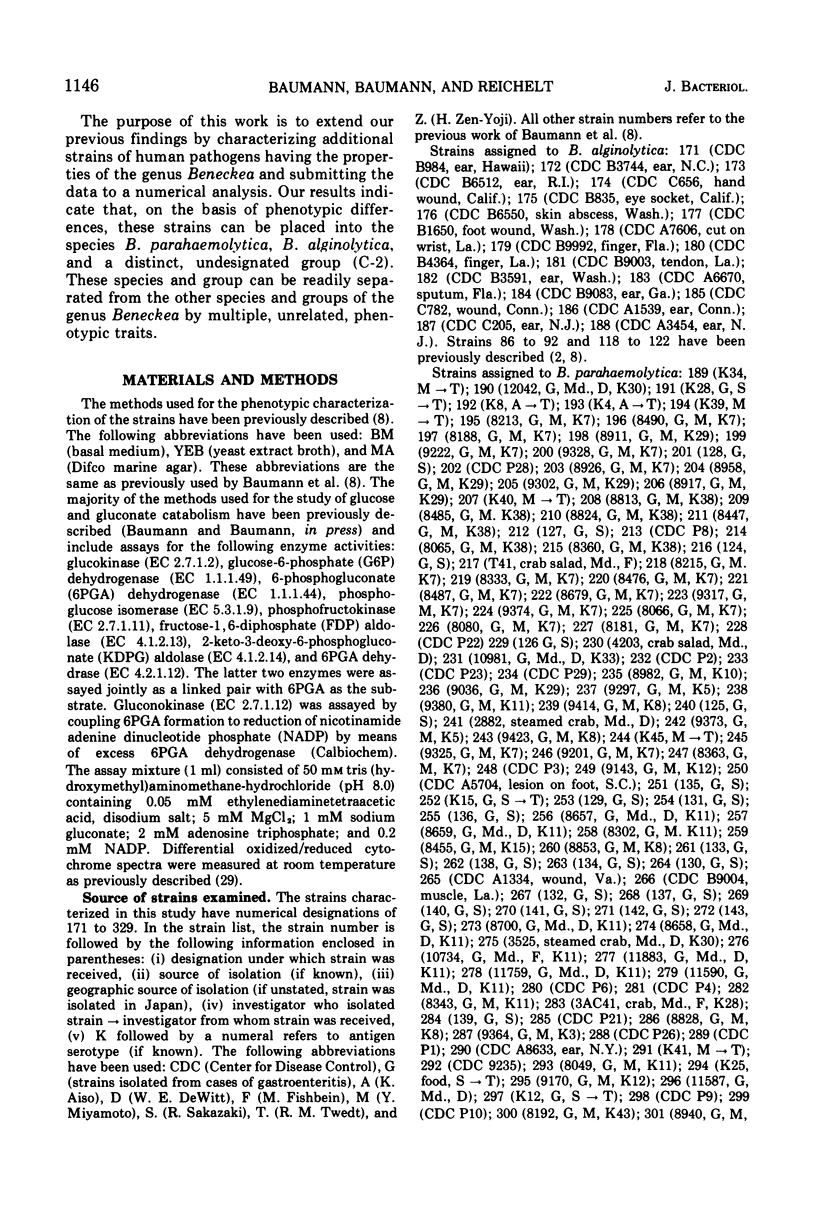
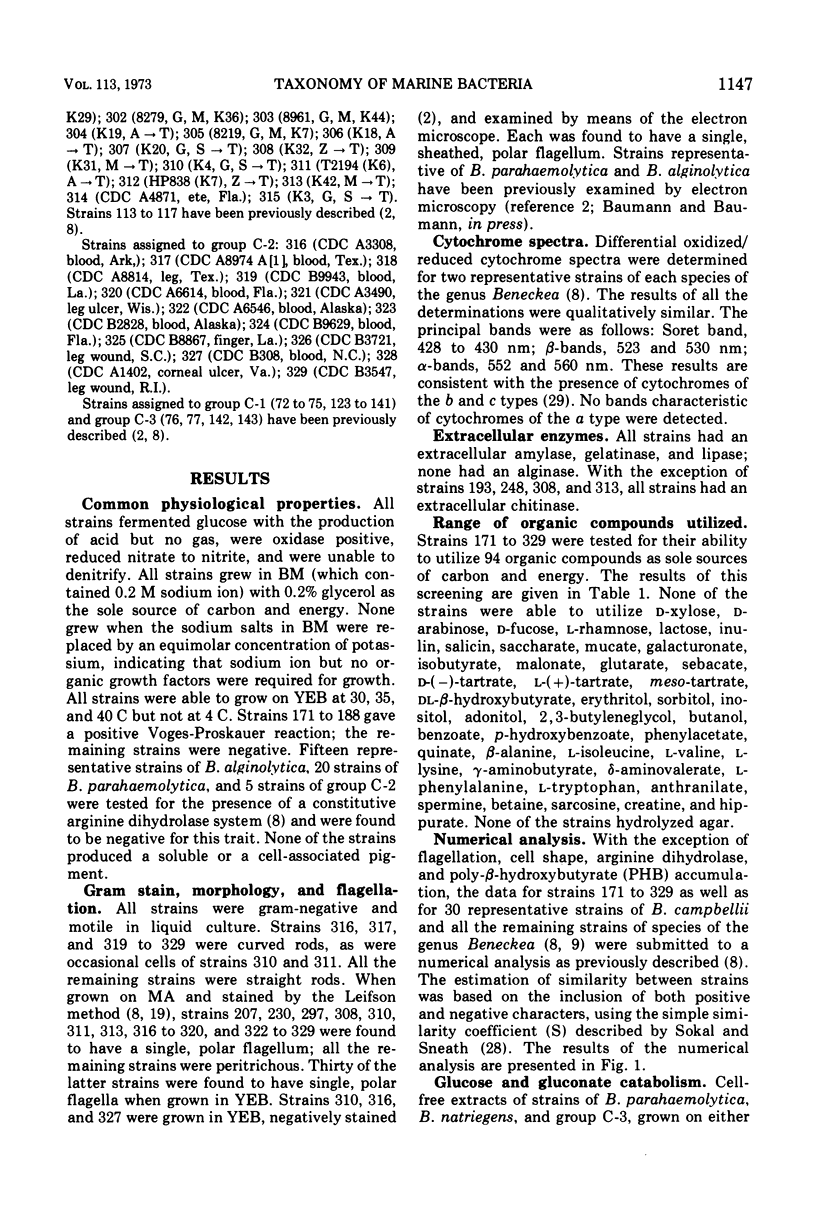
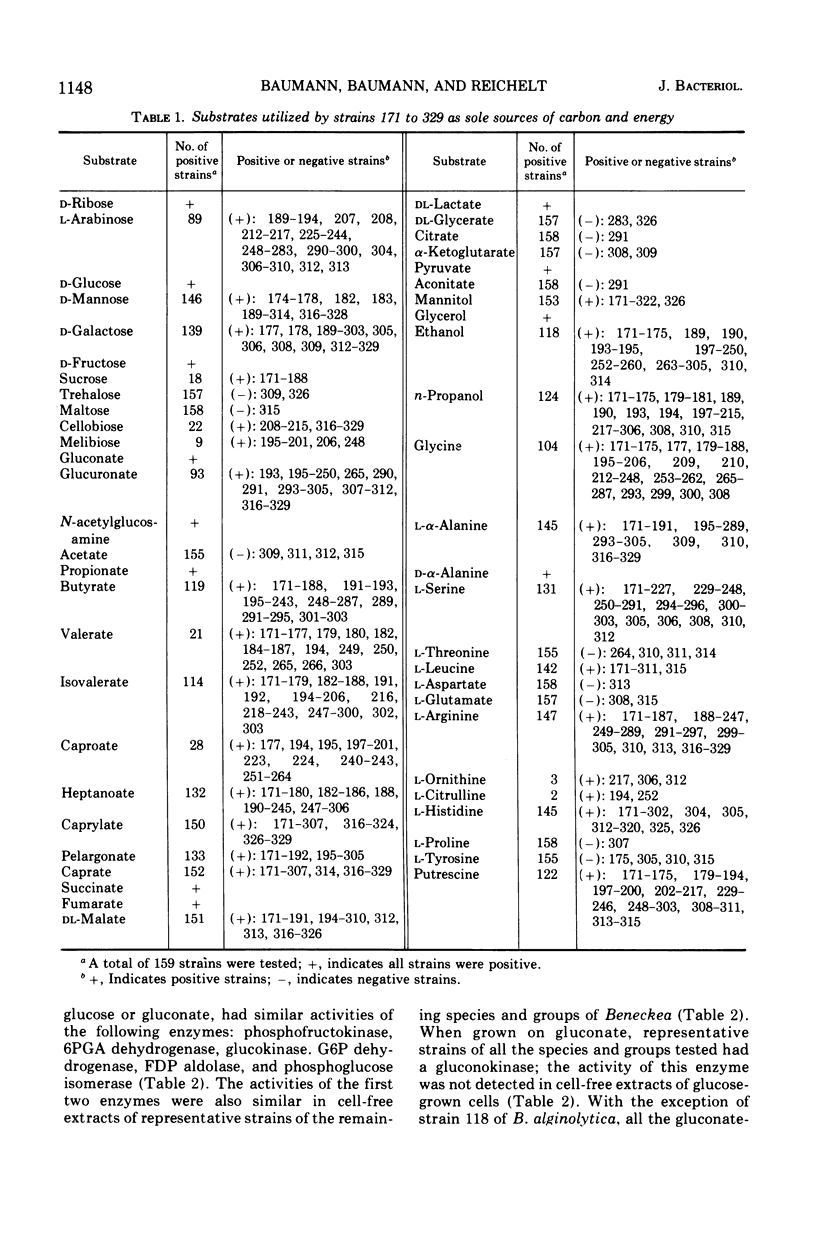
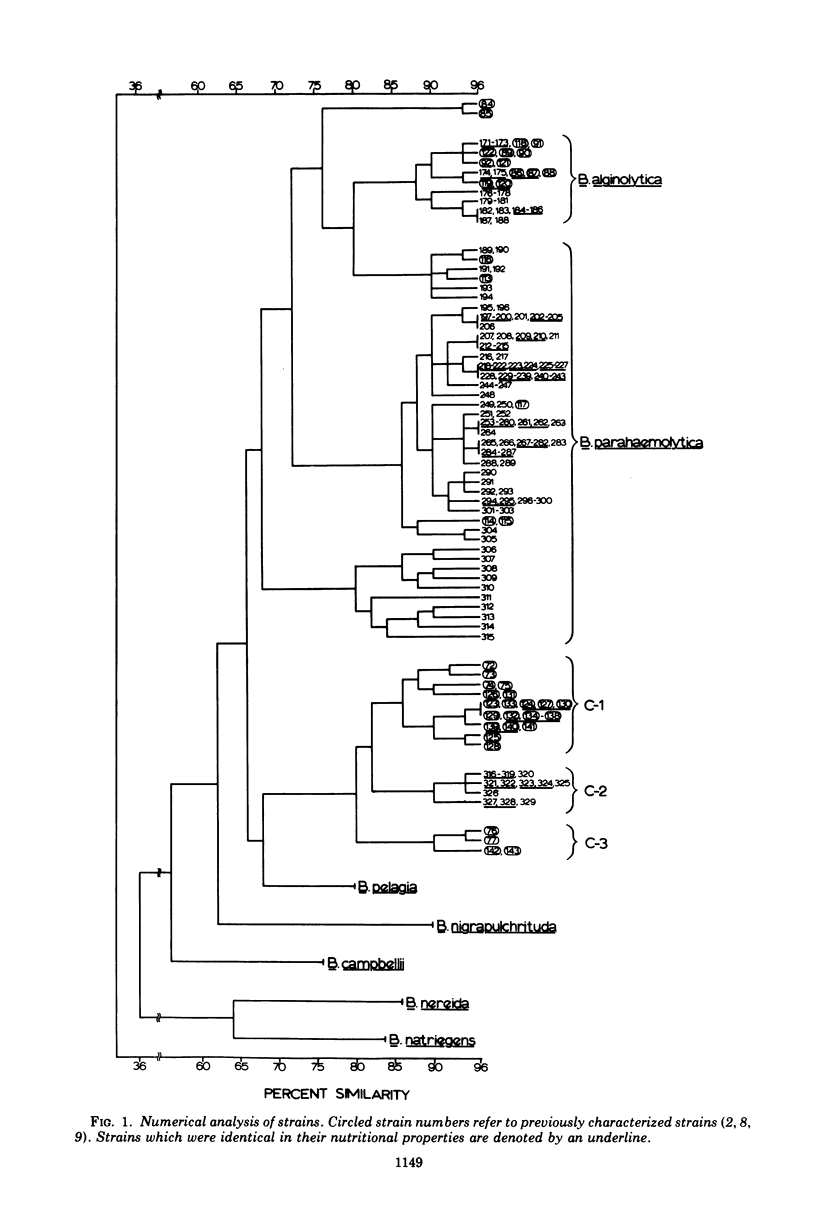
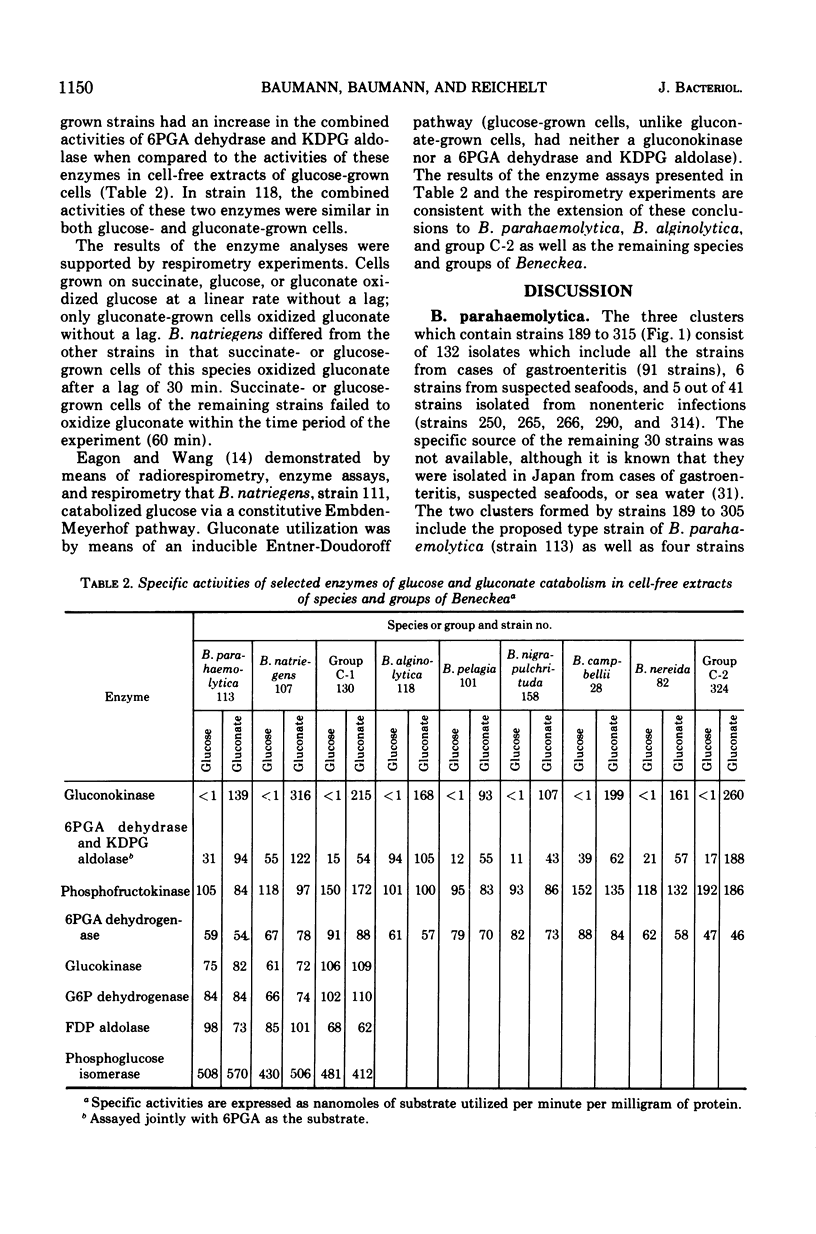
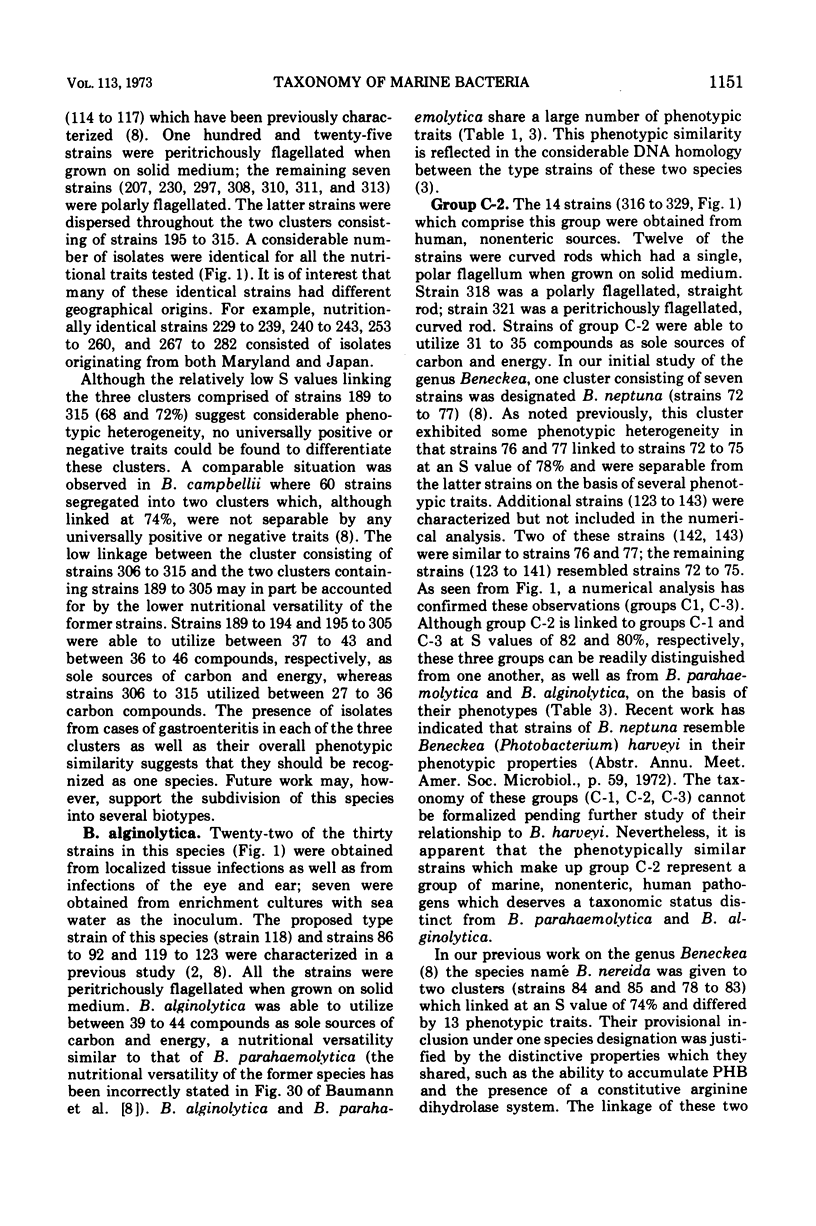
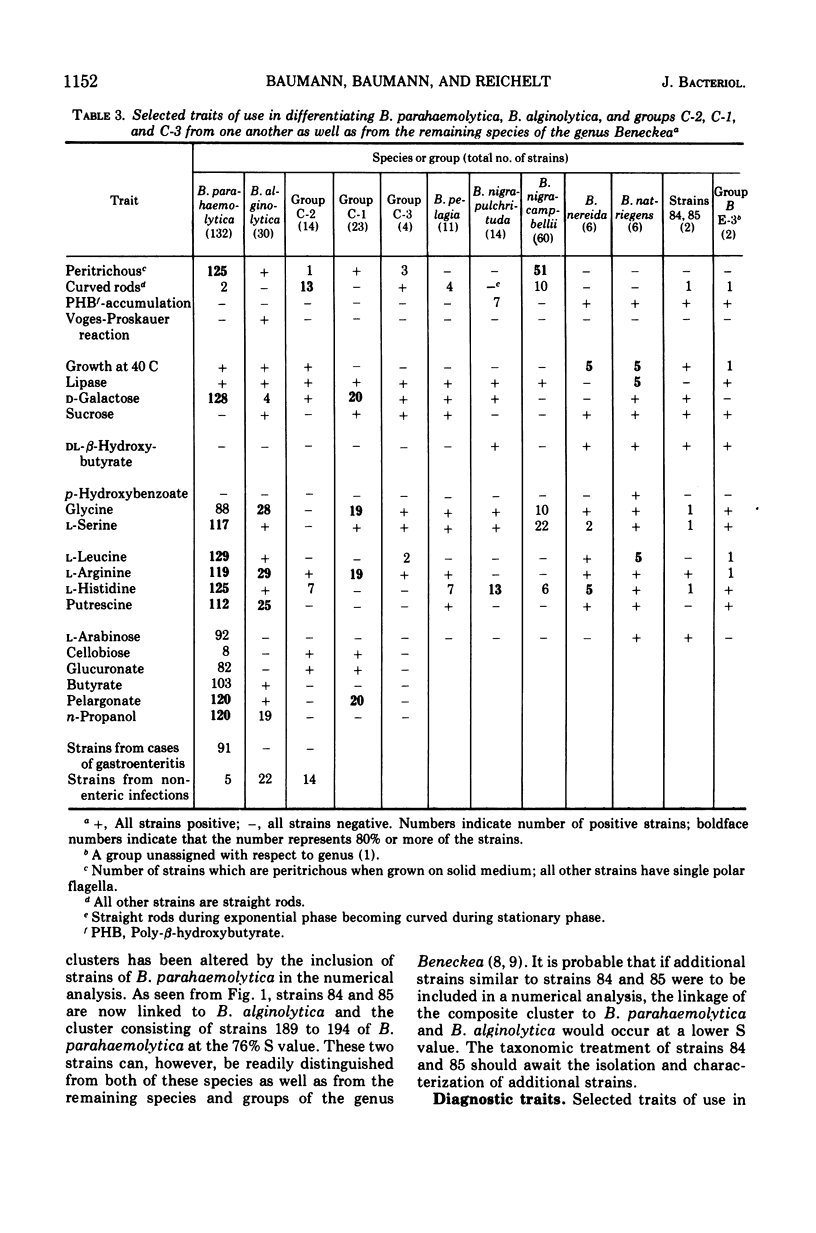
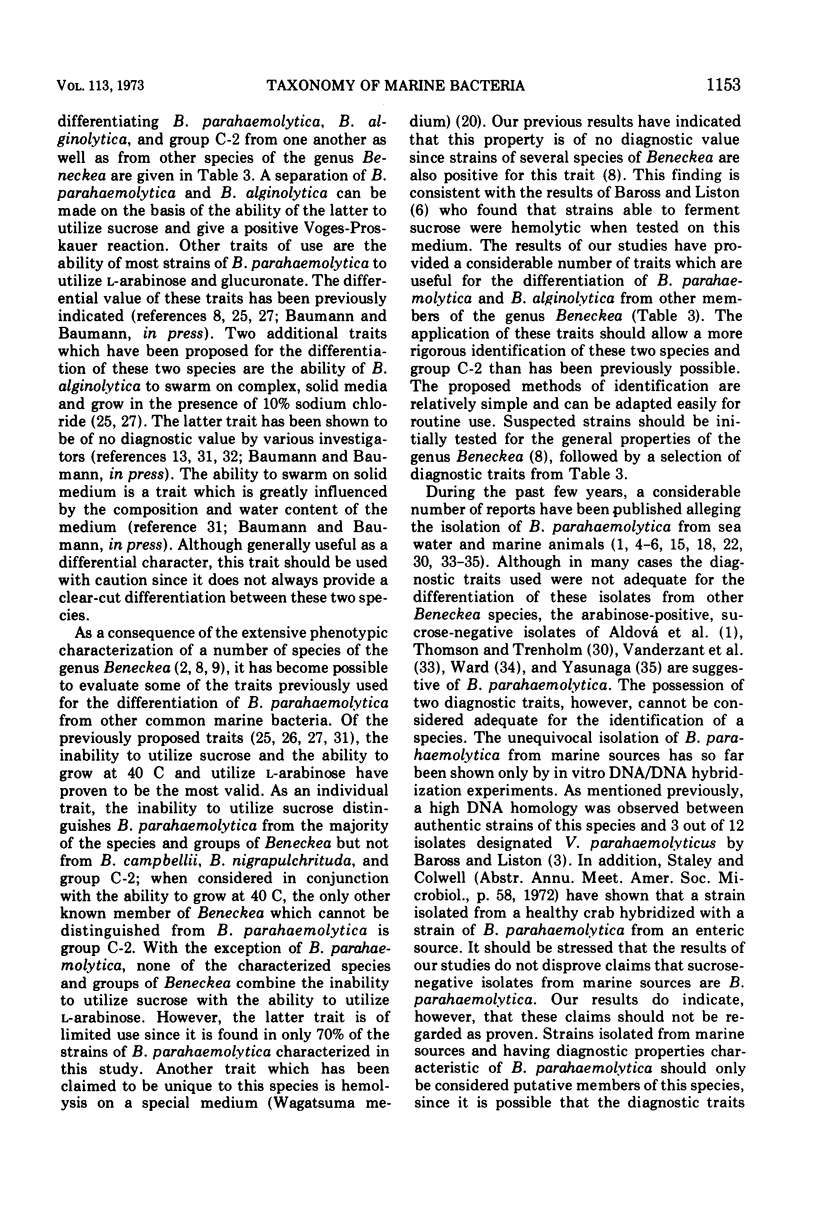
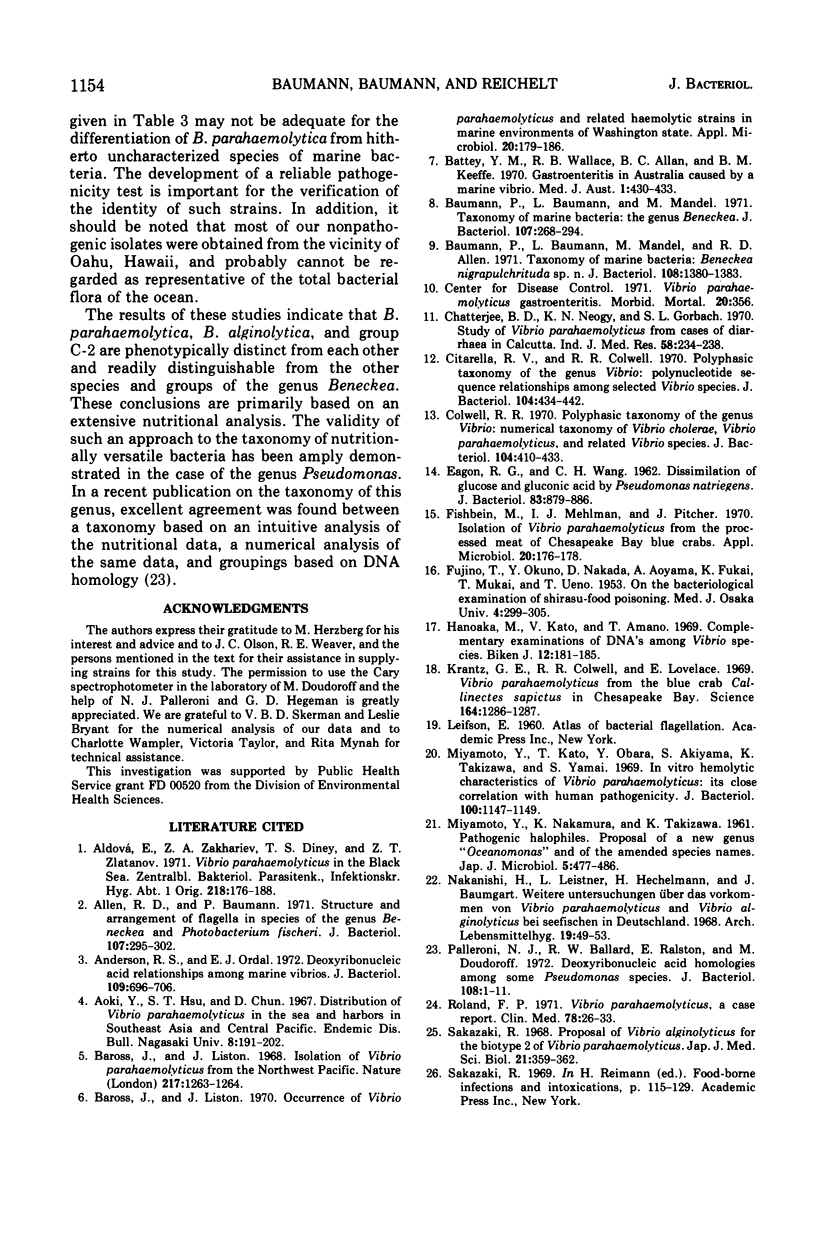
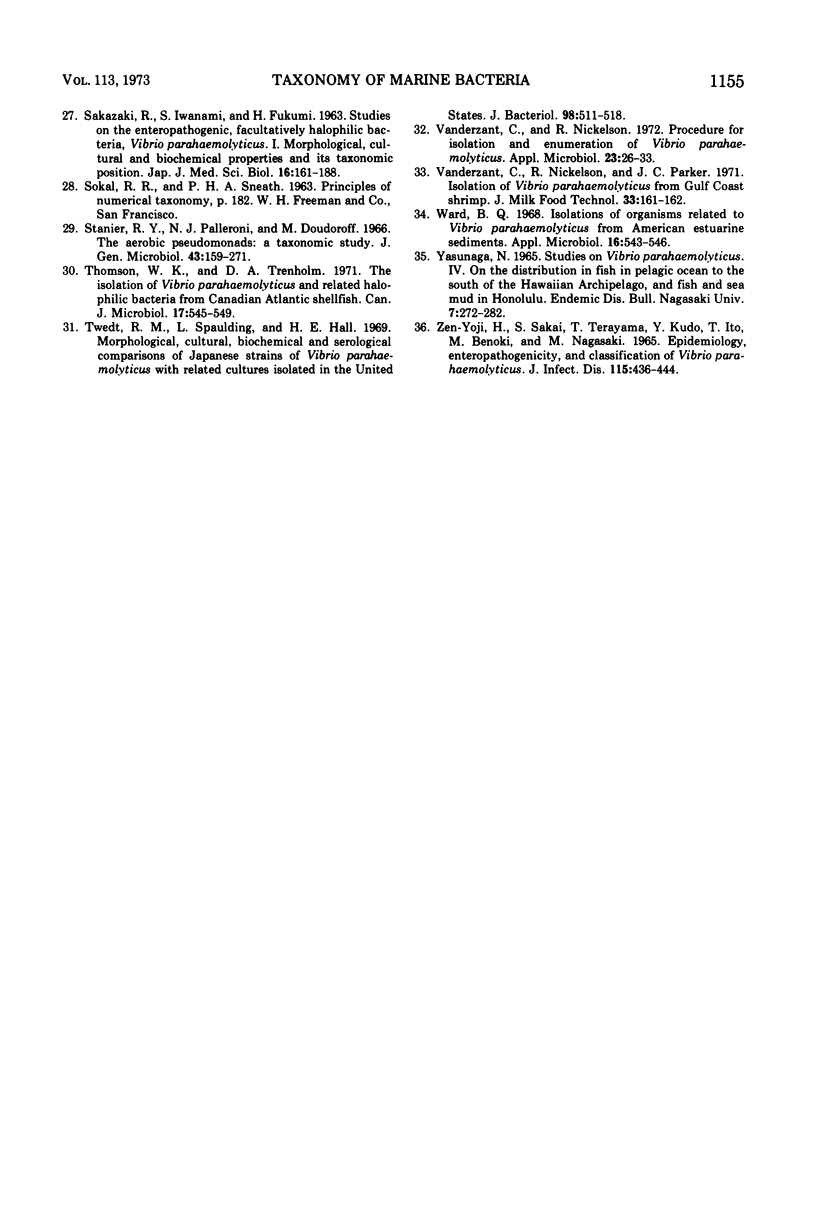
Selected References
These references are in PubMed. This may not be the complete list of references from this article.
- Aldová E., Zakhariev Z. A., Dinev T. S., Zlatanov Z. T. Vibrio parahaemolyticus im Schwarzen Meer. Zentralbl Bakteriol Orig A. 1971 Oct;218(2):176–188. [PubMed] [Google Scholar]
- Allen R. D., Baumann P. Structure and arrangement of flagella in species of the genus Beneckea and Photobacterium fischeri. J Bacteriol. 1971 Jul;107(1):295–302. doi: 10.1128/jb.107.1.295-302.1971. [DOI] [PMC free article] [PubMed] [Google Scholar]
- Anderson R. S., Ordal E. J. Deoxyribonucleic acid relationships among marine vibrios. J Bacteriol. 1972 Feb;109(2):696–706. doi: 10.1128/jb.109.2.696-706.1972. [DOI] [PMC free article] [PubMed] [Google Scholar]
- Baross J., Liston J. Isolation of vibrio parahaemolyticus from the Northwest Pacific. Nature. 1968 Mar 30;217(5135):1263–1264. doi: 10.1038/2171263a0. [DOI] [PubMed] [Google Scholar]
- Baross J., Liston J. Occurrence of Vibrio parahaemolyticus and related hemolytic vibrios in marine environments of Washington State. Appl Microbiol. 1970 Aug;20(2):179–186. doi: 10.1128/am.20.2.179-186.1970. [DOI] [PMC free article] [PubMed] [Google Scholar]
- Battey Y. M., Wallace R. B., Allan B. C., Keeffe B. M. Gastro-enteritis in Australia caused by a marine vibrio. Med J Aust. 1970 Feb 28;1(9):430–433. doi: 10.5694/j.1326-5377.1970.tb77967.x. [DOI] [PubMed] [Google Scholar]
- Baumann P., Baumann L., Mandel M., Allen R. D. Taxonomy of marine bacteria: Beneckea nigrapulchrituda sp. n. J Bacteriol. 1971 Dec;108(3):1380–1383. doi: 10.1128/jb.108.3.1380-1383.1971. [DOI] [PMC free article] [PubMed] [Google Scholar]
- Baumann P., Baumann L., Mandel M. Taxonomy of marine bacteria: the genus Beneckea. J Bacteriol. 1971 Jul;107(1):268–294. doi: 10.1128/jb.107.1.268-294.1971. [DOI] [PMC free article] [PubMed] [Google Scholar]
- Chatterjee B. D., Neogy K. N., Gorbach S. L. Study of Vibrio parahaemolyticus from cases of diarrhoea in Calcutta. Indian J Med Res. 1970 Feb;58(2):234–238. [PubMed] [Google Scholar]
- Citarella R. V., Colwell R. R. Polyphasic taxonomy of the genus Vibrio: polynucleotide sequence relationships among selected Vibrio species. J Bacteriol. 1970 Oct;104(1):434–442. doi: 10.1128/jb.104.1.434-442.1970. [DOI] [PMC free article] [PubMed] [Google Scholar]
- Colwell R. R. Polyphasic taxonomy of the genus vibrio: numerical taxonomy of Vibrio cholerae, Vibrio parahaemolyticus, and related Vibrio species. J Bacteriol. 1970 Oct;104(1):410–433. doi: 10.1128/jb.104.1.410-433.1970. [DOI] [PMC free article] [PubMed] [Google Scholar]
- EAGON R. G., WANG C. H. Dissimilation of glucose and gluconic acid by Pseudomonas natriegens. J Bacteriol. 1962 Apr;83:879–886. doi: 10.1128/jb.83.4.879-886.1962. [DOI] [PMC free article] [PubMed] [Google Scholar]
- Fishbein M., Mehlman I. J., Pitcher J. Isolation of Vibrio parahaemolyticus from the processed meat of Chesapeake Bay blue crabs. Appl Microbiol. 1970 Aug;20(2):176–178. doi: 10.1128/am.20.2.176-178.1970. [DOI] [PMC free article] [PubMed] [Google Scholar]
- Hanaoka M., Kato Y., Amano T. Complementary examination of DNA'S among Vibrio species. Biken J. 1969 Sep;12(3):181–185. [PubMed] [Google Scholar]
- Krantz G. E., Colwell R. R., Lovelace E. Vibrio parahaemolyticus from the blue crab Callinectes sapidus in Chesapeake Bay. Science. 1969 Jun 13;164(3885):1286–1287. doi: 10.1126/science.164.3885.1286. [DOI] [PubMed] [Google Scholar]
- Miyamoto Y., Kato T., Obara Y., Akiyama S., Takizawa K., Yamai S. In vitro hemolytic characteristic of Vibrio parahaemolyticus: its close correlation with human pathogenicity. J Bacteriol. 1969 Nov;100(2):1147–1149. doi: 10.1128/jb.100.2.1147-1149.1969. [DOI] [PMC free article] [PubMed] [Google Scholar]
- Palleroni N. J., Ballard R. W., Ralston E., Doudoroff M. Deoxyribonucleic acid homologies among some Pseudomonas species. J Bacteriol. 1972 Apr;110(1):1–11. doi: 10.1128/jb.110.1.1-11.1972. [DOI] [PMC free article] [PubMed] [Google Scholar]
- SAKAZAKI R., IWANAMI S., FUKUMI H. STUDIES ON THE ENTEROPATHOGENIC, FACULTATIVELY HALOPHILIC BACTERIA, VIBRIO PARAHAEMOLYTICUS. I. MORPHOLOGICAL, CULTURAL AND BIOCHEMICAL PROPERTIES AND ITS TAXONOMICAL POSITION. Jpn J Med Sci Biol. 1963 Aug;16:161–188. doi: 10.7883/yoken1952.16.161. [DOI] [PubMed] [Google Scholar]
- Sakazaki R. Proposal of Vibrio alginolyticus for the biotype 2 of Vibrio parahaemolyticus. Jpn J Med Sci Biol. 1968 Oct;21(5):359–362. doi: 10.7883/yoken1952.21.359. [DOI] [PubMed] [Google Scholar]
- Stanier R. Y., Palleroni N. J., Doudoroff M. The aerobic pseudomonads: a taxonomic study. J Gen Microbiol. 1966 May;43(2):159–271. doi: 10.1099/00221287-43-2-159. [DOI] [PubMed] [Google Scholar]
- Thomson W. K., Trenholm D. A. The isolation of Vibrio parahaemolyticus and related halophilic bacteria from Canadian Atlantic shellfish. Can J Microbiol. 1971 Apr;17(4):545–549. doi: 10.1139/m71-089. [DOI] [PubMed] [Google Scholar]
- Twedt R. M., Spaulding P. L., Hall H. E. Morphological, cultural, biochemical, and serological comparison of Japanese strains of Vibrio parahemolyticus with related cultures isolated in the United States. J Bacteriol. 1969 May;98(2):511–518. doi: 10.1128/jb.98.2.511-518.1969. [DOI] [PMC free article] [PubMed] [Google Scholar]
- Vanderzant C., Nickelson R. Procedure for isolation and enumeration of Vibrio parahaemolyticus. Appl Microbiol. 1972 Jan;23(1):26–33. doi: 10.1128/am.23.1.26-33.1972. [DOI] [PMC free article] [PubMed] [Google Scholar]
- Ward B. Q. Isolations of organisms related to Vibrio parahemolyticus from American estuarine sediments. Appl Microbiol. 1968 Mar;16(3):543–546. doi: 10.1128/am.16.3.543-546.1968. [DOI] [PMC free article] [PubMed] [Google Scholar]
- Zen-Yoji H., Sakai S., Terayama T., Kudo Y., Ito T., Benoki M., Nagasaki M. Epidemiology, enteropathogenicity, and classification of Vi.rio parahaemolyticus. J Infect Dis. 1965 Dec;115(5):436–444. doi: 10.1093/infdis/115.5.436. [DOI] [PubMed] [Google Scholar]


